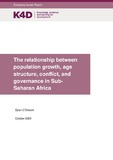| dc.contributor.author | O’Driscoll, Dylan | |
| dc.coverage.spatial | Sub-Saharan Africa | en |
| dc.date.accessioned | 2020-11-04T11:13:17Z | |
| dc.date.available | 2020-11-04T11:13:17Z | |
| dc.date.issued | 2020-10 | |
| dc.identifier.citation | O’Driscoll, D. (2020). The relationship between population growth, age structure, conflict, and governance in Sub-Saharan Africa. K4D Emerging Issues Report 38. Brighton, UK: Institute of Development Studies. | en |
| dc.identifier.uri | https://opendocs.ids.ac.uk/opendocs/handle/20.500.12413/15755 | |
| dc.description.abstract | This report addresses the relationship between population growth, age structure, and conflict in Sub-Saharan Africa (SSA). The literature reviewed for this report presents strong evidence that age structure and population growth matter for conflict. There is particularly strong evidence that points to the relationship between young age structure and conflict, although studies that disaggregate types of conflict and characteristics of young age structures (urban, male, etc.) tend to offer more robust findings. Youth bulges in particular have been associated with increased risk of conflict. The general consensus is that, in countries that will continue to experience high rates of population growth and large youth cohorts, the potential for conflict will continue to be elevated. COVID-19 is putting a dent in already weak formal employment and education. Policy responses to the pandemic will have lasting impacts for those most affected, including young people, and should therefore include them in response. The following policy recommendations are made in the literature including Patriarchal gender norms and masculinity contribute to violence and conflict, and thus policies aimed at increasing gender equality help mitigate conflict risk; The prediction that youth bulge is associated with the onset of conflict should encourage policymakers in countries with young age structures to address societal and economic inequality and foster greater inclusion of the younger cohorts into society; and Youth underemployment (and unemployment) remain an issue in SSA; bringing about structural changes that facilitate the transition into the labor market is likely to mitigate the conflict risks associated with youth bulges | en |
| dc.description.sponsorship | FCDO (Foreign, Commonwealth and Development Office) | en |
| dc.language.iso | en | en |
| dc.publisher | Institute of Development Studies | en |
| dc.relation.ispartofseries | K4D Emerging Issue Report;38 | |
| dc.rights.uri | https://www.nationalarchives.gov.uk/doc/open-government-licence/version/3/ | en |
| dc.subject | Children and Youth | en |
| dc.subject | Gender | en |
| dc.subject | Governance | en |
| dc.subject | Population | en |
| dc.subject | Security and Conflict | en |
| dc.title | The Relationship Between Population Growth, Age Structure, Conflict, and Governance in Sub- Saharan Africa | en |
| dc.type | Emerging Issues Reports | en |
| dc.rights.holder | © Crown copyright 2020 | en |
| dcterms.dateAccepted | 2020-10 | |
| rioxxterms.funder | Default funder | en |
| rioxxterms.funder | Department for International Development, UK Government | en |
| rioxxterms.identifier.project | Default project | en |
| rioxxterms.identifier.project | K4D | en |
| rioxxterms.version | VoR | en |
| rioxxterms.funder.project | 9ce4e4dc-26e9-4d78-96e9-15e4dcac0642 | en |
| rioxxterms.funder.project | 238a9fa4-fe4a-4380-996b-995f33607ba0 | en |

